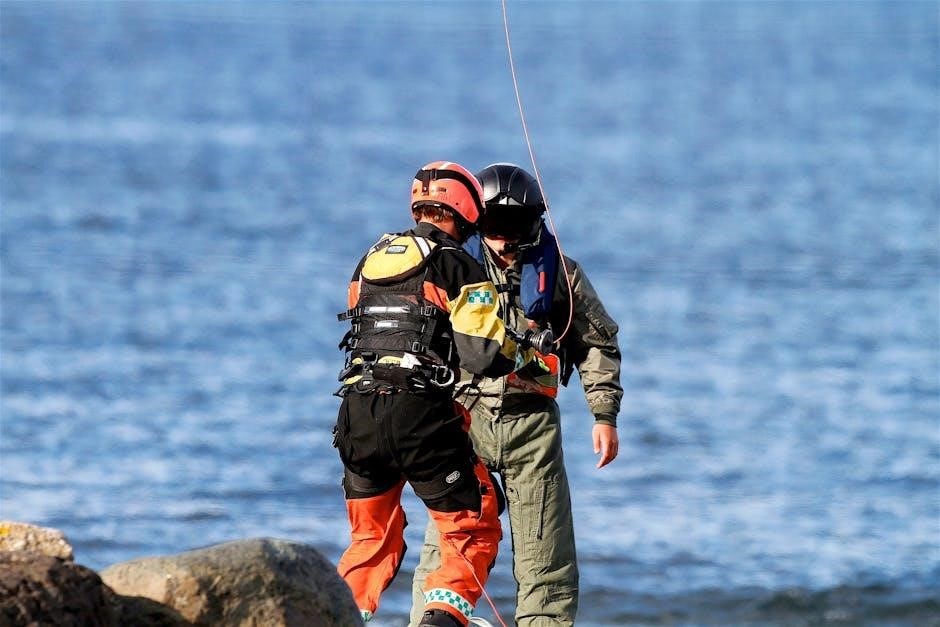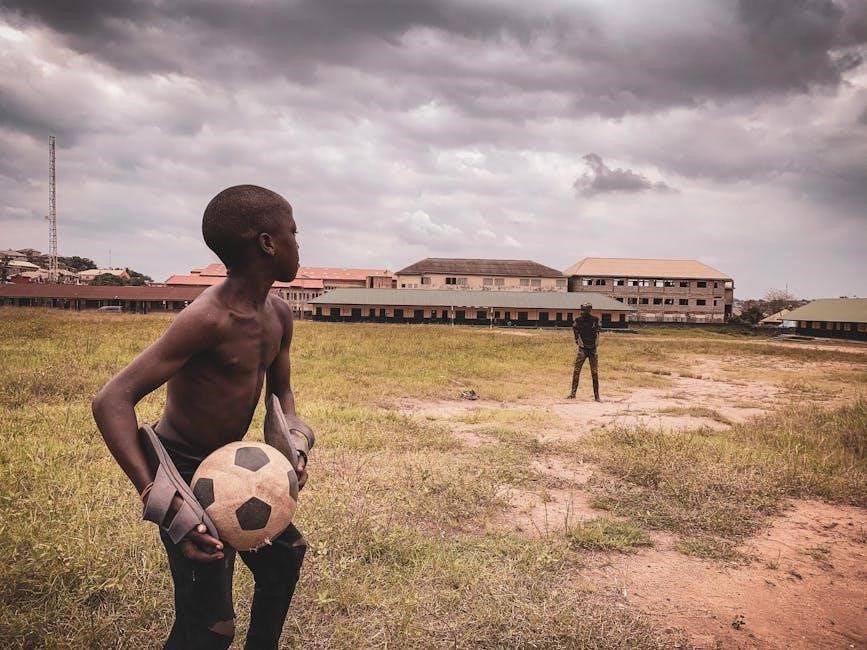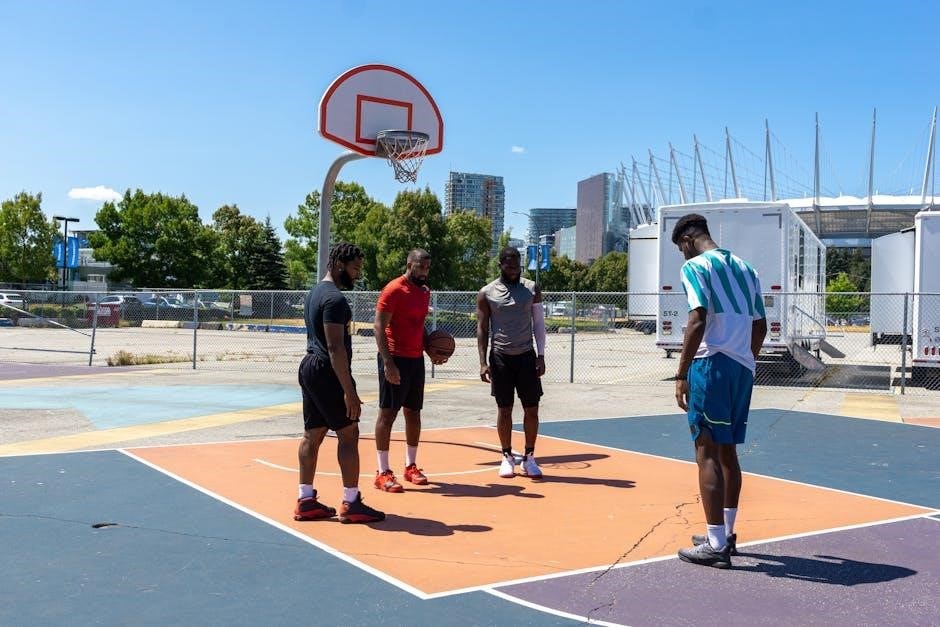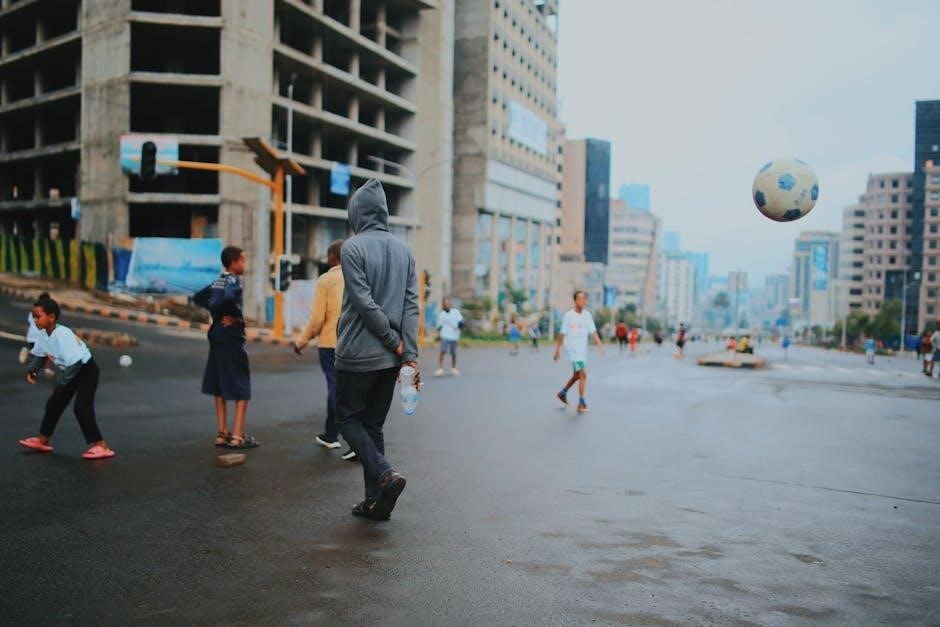Survival team building exercises are interactive simulations designed to enhance teamwork, problem-solving, and leadership. These activities immerse participants in realistic survival scenarios, fostering collaboration and critical thinking to overcome challenges.
1.1 Overview and Objectives
Survival team building exercises are structured activities designed to simulate real-life survival scenarios, fostering teamwork, problem-solving, and leadership. These exercises typically involve groups navigating challenging situations, such as being lost at sea, stranded after a plane crash, or surviving on a desert island. The primary objective is to encourage collaboration, communication, and adaptability among participants. By immersing teams in realistic dilemmas, these exercises help individuals identify their natural roles within a group, whether as leaders, strategists, or supporters. The goals include enhancing trust, improving decision-making under pressure, and fostering a sense of camaraderie. Participants also gain practical survival skills, such as prioritizing resources and managing time effectively. Ultimately, these exercises aim to prepare teams for real-world challenges by testing their ability to work together and think critically in high-stakes environments.
1.2 Importance of Teamwork in Survival Scenarios
Teamwork is paramount in survival scenarios, as it ensures collective strength and resourcefulness. When facing life-threatening situations, such as being lost at sea or stranded after a plane crash, collaboration is essential for dividing tasks, sharing responsibilities, and maximizing chances of survival. Teamwork fosters trust, communication, and mutual support, which are critical for maintaining morale and focus under stress. By working together, individuals can pool their skills and knowledge, leading to more effective problem-solving and decision-making. Additionally, teamwork helps distribute the physical and mental burden, preventing burnout and ensuring sustained effort. In survival exercises, participants learn to rely on each other’s strengths, fostering adaptability and resilience. This collective approach not only enhances survival prospects but also strengthens interpersonal bonds, making teams more cohesive and effective in real-world challenges.
Popular Survival Scenarios for Team Building
Survival scenarios like being lost at sea, stranded after a plane crash, or surviving on a desert island are widely used for team building. These immersive challenges simulate real-life threats, fostering problem-solving, leadership, and collaboration. Participants must work together to allocate resources, prioritize tasks, and make critical decisions, mirroring the pressures of real survival situations. Such exercises not only test teamwork but also reveal individual strengths and roles within a group, enhancing overall cohesion and preparedness for adversity.
2.1 Lost at Sea Survival Scenario
The “Lost at Sea” scenario is a classic team-building exercise where participants imagine being stranded in the ocean after a shipwreck. The objective is to survive until rescue by working together to allocate limited resources and make life-saving decisions. Teams must rank the usefulness of available survival items, such as water, food, flares, and first-aid kits, to maximize their chances of survival. This activity encourages problem-solving, communication, and collaboration, as team members must agree on priorities and strategies. It also reveals individual roles within the group, such as leaders, planners, and executors. The exercise is both engaging and educational, teaching participants essential survival skills while fostering teamwork and adaptability in high-pressure situations.
2.2 Plane Crash Survival Simulation
The “Plane Crash Survival Simulation” immerses teams in a scenario where they have just survived a small plane crash, with the pilot and co-pilot deceased. Set in mid-January, participants must navigate the harsh, cold environment to survive until rescue. Teams are tasked with prioritizing resources, such as food, water, and medical supplies, to sustain themselves while addressing injuries and potential hazards. This exercise emphasizes decision-making under pressure, resource management, and collaboration. Participants learn to allocate tasks based on strengths and weaknesses, fostering leadership and adaptability. The simulation also highlights the importance of staying calm and working collectively to overcome life-threatening challenges, making it an effective tool for building resilience and teamwork in high-stakes situations.
2.3 Desert Island Survival Exercise
The “Desert Island Survival Exercise” challenges teams to envision themselves stranded on a remote island after a plane crash. Participants are divided into groups and must select four essential items from a provided worksheet to ensure their survival. This activity encourages critical thinking, as teams weigh the importance of items like food, water, first aid kits, and communication tools. The exercise fosters collaboration and decision-making, as members must agree on priorities and strategies. It also reveals natural leadership roles and problem-solving abilities within the group. The simulation concludes with a discussion on the rationale behind their choices, promoting reflection and learning. This exercise is both engaging and educational, helping teams develop practical survival skills while enhancing their ability to work together under stress.
2.4 Blizzard Survival Challenge
The “Blizzard Survival Challenge” immerses teams in a harsh winter scenario where they must survive a severe snowstorm. Participants are given a list of survival items and must rank them in order of importance to stay alive. This exercise simulates the cold, isolation, and urgency of a real blizzard, pushing teams to think critically and prioritize resources. The activity encourages collaboration and decision-making under pressure, as members must agree on their rankings. Afterward, a debriefing session reveals the optimal choices, fostering learning and reflection. This challenge not only tests practical survival skills but also enhances teamwork, adaptability, and problem-solving abilities, making it a powerful tool for building resilient teams.
2.5 Space Crew Survival Dilemma
The “Space Crew Survival Dilemma” places teams in a futuristic, high-stakes scenario where they are part of a space crew stranded on the moon’s surface. Originally scheduled to rendezvous with a mother ship, the crew now faces a critical situation due to unforeseen challenges. Participants must work together to prioritize resources, address equipment malfunctions, and navigate the harsh lunar environment. This exercise emphasizes adaptability, resourcefulness, and strategic thinking. Teams must allocate limited supplies, manage risks, and make tough decisions to ensure their survival until rescue. The activity fosters innovation and collaboration, as members rely on each other’s strengths to overcome the unique challenges of space survival. This scenario is both engaging and educational, offering valuable insights into crisis management and teamwork in extreme conditions.
Key Elements of Survival Team Building Exercises

Survival exercises emphasize problem-solving, decision-making, leadership, communication, and adaptability. They foster resourcefulness, teamwork, and time management, preparing participants for real-world challenges through immersive, collaborative experiences.
3.1 Problem-Solving and Decision-Making
Problem-solving and decision-making are critical components of survival team building exercises. These activities present participants with complex, high-stakes scenarios that require quick, effective solutions. For instance, in a plane crash simulation, teams must prioritize resources and navigate harsh environments. Such challenges encourage creative thinking and strategic planning. Participants learn to evaluate options, weigh risks, and make decisive actions under pressure, mirroring real-life crisis situations. These exercises also reveal individual problem-solving styles, fostering a collaborative approach where diverse perspectives lead to innovative solutions. By simulating survival dilemmas, teams enhance their ability to adapt and make sound decisions, essential for both survival scenarios and everyday professional challenges.
3.2 Leadership and Role Identification

Leadership and role identification are vital in survival team building exercises, as they mirror real-world dynamics. These simulations reveal natural leaders who emerge to guide the group, while others adopt supportive roles. For example, in a desert island scenario, participants must assign tasks based on strengths, fostering accountability and cooperation. Such exercises help individuals recognize their leadership styles and how they contribute to team success. By observing these dynamics, facilitators can provide feedback, encouraging growth and awareness. These insights are invaluable for improving teamwork and leadership skills in professional settings, emphasizing the importance of collaboration and adaptability in overcoming challenges.
3.3 Communication and Collaboration
Effective communication and collaboration are cornerstone elements in survival team building exercises. These activities emphasize the importance of clear dialogue to ensure all team members understand their roles and responsibilities. For instance, in a plane crash simulation, participants must discuss and agree on priorities, such as locating shelter or signaling for help. Poor communication can lead to misunderstandings, while strong collaboration fosters unity and shared goals. By working together, teams learn to pool their knowledge and skills, enhancing problem-solving capabilities. These exercises highlight how seamless communication and active listening are critical for success in both survival scenarios and real-life professional environments. They also reveal the value of diverse perspectives in achieving common objectives, making them invaluable tools for team development and cohesion.
3.4 Time Management and Prioritization
Time management and prioritization are essential skills honed through survival team building exercises. In high-stakes scenarios, such as a plane crash or being stranded in a blizzard, teams must quickly assess situations and allocate tasks efficiently. These exercises teach participants to prioritize actions based on urgency and importance, ensuring resources are used effectively. For example, in a desert island survival exercise, teams must decide whether to focus on building shelter or finding food first. Poor time management can lead to wasted resources and decreased chances of survival. By practicing prioritization, teams learn to make swift, informed decisions under pressure, enhancing their ability to adapt to dynamic challenges. These skills translate to real-world scenarios, improving productivity and decision-making in professional environments. Effective time management becomes a critical tool for overcoming obstacles and achieving success.
3.5 Adaptability and Resourcefulness
Survival team building exercises emphasize adaptability and resourcefulness, crucial for overcoming unpredictable challenges. In scenarios like being lost at sea or stranded in a blizzard, teams must think creatively to utilize limited resources. For instance, using a plane’s wreckage for shelter or fashioning tools from available materials demonstrates resourcefulness. These exercises teach participants to pivot strategies when initial plans fail, fostering resilience. Adaptability is tested as teams encounter unexpected obstacles, requiring quick adjustments to survive. Resourcefulness encourages innovative problem-solving, such as starting a fire without modern tools or signaling for help with minimal equipment. These skills enhance real-world teamwork by preparing individuals to handle unforeseen challenges effectively. By simulating survival situations, exercises participants’ ability to remain calm, think critically, and adapt seamlessly, ensuring they can thrive in any environment. This ability to adapt and innovate becomes a cornerstone of successful collaboration in both survival and professional settings.

Designing a Survival Team Building Exercise
Designing involves creating realistic scenarios, defining objectives, and incorporating challenges that promote teamwork, problem-solving, and adaptability, ensuring a meaningful and engaging learning experience for participants.
4.1 Defining Clear Objectives and Goals
Defining clear objectives and goals is crucial for ensuring the effectiveness of survival team building exercises. These objectives should align with the desired outcomes, such as improving teamwork, problem-solving, and leadership skills. By setting specific goals, participants understand what is expected of them and can focus their efforts accordingly. For example, objectives might include prioritizing survival tasks, allocating resources effectively, or working collaboratively to overcome challenges. Clear goals also help facilitators assess the success of the exercise and identify areas for improvement. When objectives are well-defined, participants are more likely to engage fully and derive meaningful insights from the experience. This step ensures that the exercise is purposeful and directly contributes to the development of essential survival and teamwork skills.
4.2 Selecting Appropriate Survival Scenarios
Selecting appropriate survival scenarios is essential for creating engaging and relevant team building exercises. Scenarios should align with the group’s needs, skill levels, and the desired learning outcomes. Examples include being stranded on a desert island, surviving a plane crash, or navigating a blizzard. These scenarios should be realistic and immersive to encourage active participation. Consider the group’s size, time constraints, and the complexity of challenges to ensure the exercise is manageable yet impactful. Scenarios that involve resource allocation, prioritization, and problem-solving are particularly effective. They should also allow for diverse roles and responsibilities, enabling team members to contribute based on their strengths. The chosen scenario should foster collaboration, adaptability, and creativity, making it a valuable learning experience for all participants.

4.3 Creating Realistic and Engaging Challenges
Creating realistic and engaging challenges is crucial for effective survival team building exercises. These challenges should simulate real-life survival situations, such as navigating a desert island or surviving a blizzard. Incorporate tasks that require problem-solving, resource management, and teamwork. For example, participants might need to prioritize items for survival or build shelter using limited materials. Realistic props and environments enhance immersion, making the experience more impactful. Clear instructions and time constraints add pressure, mimicking actual survival conditions. Challenges should also encourage creativity and adaptability, allowing teams to think outside the box. Ensuring that each challenge builds on previous ones creates a progression of difficulty, keeping participants engaged throughout the exercise. This approach fosters collaboration, leadership, and critical thinking, making the challenges both educational and memorable for the team.
4.4 Incorporating Debriefing Sessions
Incorporating debriefing sessions is a critical component of survival team building exercises. These sessions provide an opportunity for participants to reflect on their experiences, discuss challenges faced, and identify lessons learned. A structured debriefing format ensures that teams can analyze their performance, communication, and decision-making processes. Facilitators should guide the discussion to highlight successes and areas for improvement, fostering open dialogue and encouraging feedback. Debriefing sessions also help participants connect the skills they’ve learned to real-world scenarios, enhancing their ability to apply these strategies in future challenges. By fostering a reflective environment, debriefing strengthens team bonds and reinforces the value of collaboration and adaptability. This step is essential for maximizing the learning outcomes of the exercise and ensuring long-term personal and professional growth for all participants.

Implementing Survival Team Building Exercises
Implementing survival exercises involves briefing participants, organizing teams, and setting up realistic scenarios. Facilitators monitor progress, ensuring engagement and fostering an environment where skills and teamwork are honed effectively.
5.1 Pre-Exercise Briefing and Instructions
A thorough pre-exercise briefing ensures participants understand the scenario, objectives, and rules. Instructions outline roles, available resources, and safety guidelines, setting clear expectations for the simulation. This step is crucial for aligning teams and promoting engagement from the start.

5.2 Dividing Participants into Teams

Dividing participants into teams is a critical step in survival team building exercises, as it fosters collaboration and shared responsibility. Teams are typically small, ranging from 4 to 8 members, to ensure active participation. Random assignment or intentional grouping based on diverse skills and personalities can be used to promote inclusivity. Clear roles or positions within the team, such as leader, communicator, or problem-solver, may be assigned to encourage accountability. This division mimics real-life survival scenarios, where teamwork and coordination are essential for success. The goal is to create balanced teams that can effectively work together to overcome challenges, fostering camaraderie and mutual reliance.
5.3 Setting Up the Simulation Environment
Setting up the simulation environment is essential for creating an immersive survival team building experience. The area should be designed to mimic real-life survival conditions, such as a desert, forest, or stranded island. Props, obstacles, and weather-like conditions can enhance realism. Safety is a priority, so the space must be clear of hazards and equipped with necessary safety gear. Instructions and scenario details are provided to participants beforehand to set the context. The environment should challenge teams physically and mentally, encouraging problem-solving and collaboration. Limited resources, such as water, food, or tools, can add intensity to the exercise. A well-prepared setting ensures participants engage fully, fostering teamwork and adaptability. The simulation environment acts as a catalyst for learning and growth, making the experience memorable and impactful.
5.4 Monitoring Team Progress and Dynamics
Monitoring team progress and dynamics is crucial for ensuring the effectiveness of survival team building exercises. Facilitators observe how teams collaborate, make decisions, and adapt to challenges. This involves tracking problem-solving strategies, communication patterns, and leadership emergence. Real-time feedback is provided to guide teams without interfering with the natural progression of the exercise. Observations help identify strengths and areas for improvement, enabling tailored interventions. The goal is to foster growth while maintaining the integrity of the simulation. By closely monitoring interactions, facilitators can assess how well teams align with the exercise’s objectives, such as enhancing teamwork and resourcefulness. This step ensures the exercise remains engaging and impactful, while also providing valuable insights for post-exercise debriefing sessions.

Evaluating the Effectiveness of Survival Team Building
Evaluating effectiveness involves assessing team performance, gathering feedback, and measuring improved collaboration and communication; This ensures exercises achieve their goals and refine future team-building strategies.
6.1 Assessing Team Performance and Outcomes
Assessing team performance involves evaluating how effectively participants work together to achieve survival goals. This includes observing problem-solving skills, decision-making processes, and collaboration. Outcomes are measured by the team’s ability to complete tasks, such as prioritizing survival items or navigating challenges. Trainers often use observation checklists to document teamwork dynamics and identify strengths or weaknesses. Feedback from participants and instructors provides additional insights into the exercise’s success. By analyzing performance metrics, organizations can determine if the exercise improved communication, leadership, and adaptability. This evaluation helps refine future team-building activities and ensures they align with organizational objectives. The goal is to create a clear understanding of what worked well and what areas need improvement for enhanced team effectiveness in real-world scenarios.
6.2 Gathering Participant Feedback
Gathering participant feedback is crucial for understanding the effectiveness of survival team-building exercises. This step involves collecting insights from individuals about their experiences, challenges, and perceived benefits. Feedback can be gathered through surveys, group discussions, or one-on-one interviews. Participants often share how the exercise helped them identify their roles within a team and improve communication. Feedback also highlights areas for improvement, such as time management or decision-making processes. By analyzing these responses, organizers can refine the exercise to better meet learning objectives. Additionally, feedback provides a platform for participants to reflect on their personal growth and teamwork skills. This iterative process ensures that future exercises are more engaging and relevant, ultimately enhancing the overall learning experience for everyone involved.
6.3 Measuring Improved Collaboration and Communication
Measuring improved collaboration and communication is essential to evaluating the success of survival team-building exercises. This can be achieved by observing team dynamics during the simulation and assessing how effectively members work together. Feedback from participants and facilitators provides valuable insights into communication strengths and areas for improvement. Observing how teams resolve conflicts and share responsibilities also highlights collaboration levels. Additionally, pre- and post-exercise assessments, such as communication style surveys or role-playing exercises, can quantify improvements. By analyzing these metrics, organizers can determine whether the exercise enhanced teamwork and interpersonal skills. Improved collaboration and communication are often reflected in faster problem-solving, clearer decision-making, and a more cohesive team environment, all of which are critical for survival scenarios and real-world applications.
6.4 Analyzing Leadership Development
Analyzing leadership development is a critical component of evaluating survival team-building exercises. These simulations often reveal natural leaders and help participants develop leadership skills. Observing how individuals take charge, make decisions, and guide their teams provides insights into their leadership potential. Feedback from facilitators and peers can highlight strengths and areas for improvement. Leadership development is also assessed through post-exercise surveys and reflections, where participants share their experiences and perceptions of their roles. Effective leadership in survival scenarios often translates to real-world applications, fostering confidence and decision-making abilities. By identifying and nurturing leadership qualities, these exercises empower individuals to lead effectively in challenging situations, both within the simulation and beyond.

Survival team building exercises foster lasting improvements in teamwork, leadership, and problem-solving. Participants gain practical skills and confidence, applicable to real-world challenges, enhancing overall collaboration and resilience.
7.1 Reinforcing Teamwork and Survival Skills
Survival team building exercises are designed to reinforce teamwork and survival skills through immersive, challenging scenarios. These activities encourage participants to collaborate, communicate, and rely on each other to overcome obstacles. By simulating real-life survival situations, such as being stranded on a desert island or surviving a plane crash, individuals learn to prioritize tasks, allocate resources, and make decisions under pressure. These exercises also foster adaptability, resourcefulness, and leadership, which are critical for survival. The hands-on nature of these simulations ensures that participants not only learn theoretical concepts but also gain practical experience. Over time, these skills become ingrained, enhancing overall teamwork and survival capabilities in both simulated and real-world scenarios. The long-term impact of these exercises is evident in improved collaboration, problem-solving, and confidence among team members.
7.2 Encouraging Continued Learning and Growth
Survival team building exercises are not only about immediate skill development but also about fostering a mindset of continuous learning and growth. These activities provide participants with practical experiences that can be reflected upon and applied in future challenges. By engaging in realistic survival scenarios, individuals gain insights into their strengths and areas for improvement, motivating them to seek further development. Debriefing sessions after exercises allow teams to analyze their performance, identifying successful strategies and areas needing refinement; This iterative process encourages participants to adopt a growth mindset, where they view challenges as opportunities to learn and improve. Over time, this leads to enhanced problem-solving abilities, better communication, and a greater sense of adaptability. The long-term impact of these exercises lies in their ability to inspire ongoing personal and professional development.
7.3 Applying Lessons to Real-World Scenarios
Survival team building exercises equip participants with skills that are highly transferable to real-world scenarios. The problem-solving, decision-making, and adaptability cultivated during these simulations are invaluable in everyday challenges. For instance, the ability to prioritize tasks and manage resources effectively can enhance workplace efficiency and crisis management. Communication and collaboration skills honed during survival exercises improve teamwork in professional settings, fostering better project outcomes. Additionally, the leadership skills developed during these activities empower individuals to take charge in real-life situations, whether in emergency response or organizational leadership. By bridging the gap between simulated challenges and real-world applications, survival team building exercises create a lasting impact on personal and professional development. This practical application ensures that the lessons learned are not confined to the exercise but become integral to daily life and work.
Comments